(Last updated on February 13th, 2023)
Without the right chain lube, your bike will run slower and wear down your precious drivetrain. Boost efficiency and drivetrain health by properly applying the correct lube.
Chain lubricant allows the chain to have smooth contact with the gears and decreases friction among the internal components of the chain. The overall objective of lube is to lower friction across the entire system to increase efficiency. Lube works its way inside the rollers and pins of the chain to prevent rust and ensure that the chain is flexible as it spins around the drivetrain.
Read this complete buyer’s guide to the best bike chain lubes of 2023 to get all the answers to the ideal lubricants for any situation.
- Why Is Chain Lube Important?
- How to Take Care of Your Chain
- What Are the Different Types of Chain Lubes?
- Bike Chain Lube Buyer’s Guide
- How We Rated These Lubes
- Compare the Best Bike Chain Lubes at a Glance
- Best Overall Budget Lube
- Best Race Day Lube
- Best Lube When Money is No Object
- Best All-Conditions Lube
- Best Lube for Wet Conditions
- Best Eco-Friendly Lube
- Frequently Asked Questions
Why Is Chain Lube Important?
Using chain lube is one of the easiest ways to keep your bike in top shape. Properly lubricating the chain increases the drivetrain’s efficiency and prevents excessive wear on the system. The right chain lube is a key ingredient to going as fast as possible and extending the life of your components.
Efficiency
A clean and well-lubricated chain increases your bike’s efficiency by limiting the energy lost to friction in the drivetrain. The metal-on-metal contact between the chain and various gears can leak energy, resulting in less power for the same pedaling effort.
Drivetrain efficiency is the amount of energy that a rider puts through the pedals, which actually reaches the rear wheel to move the bike. In controlled tests, drivetrains can reach 98% efficiency, losing very little power due to friction.
A dirty chain and exposure to the elements can send efficiency tumbling down. Proper lubrication is just as important as keeping your bike clean and equipped with the right components to get the most out of your drivetrain.
Drivetrain Wear
Another advantage of lubrication is decreased wear across the entire drivetrain system, including the chain, rear cassette, and front chainrings. Those metal components are constantly in contact with each other and can wear down quickly when there isn’t sufficient lubricant to keep things running smoothly.
The right amount of lube lowers the friction during that metal-on-metal contact to avoid dulling gear teeth and wearing down the chain.
Chain lube also tries to prevent dirt and contaminants from adhering to the drivetrain and causing even more damage. Riding out in the elements can cover the chain in an abrasive combination of dirt and grime. That mixture forms a gritty paste that grinds away at the gears and can get in the way of reliable shifting performance.
How to Take Care of Your Chain
1. A clean chain is a happy chain: Bike mechanics can’t stress this tip enough. Keeping your chain clean not only makes your bike shine, it increases efficiency and limits drivetrain wear. Take a moment to clean your chain after every few rides rather than a huge overhaul once a season your drivetrain will thank you.
2. Choose the right bike lube for the job: There are several different types of bike chain lubes. Some are specifically designed for dry conditions, riding in the rain, and racing. Wet lube helps prevent mud from sticking to the chain and gunking up the system. Use the lube that best matches the conditions in which you normally ride.
3. Add the proper amount of bike lube: Too little and it won’t make a difference, and overdoing it can attract dirt and contaminants to the chain. Be patient when applying lube, and make sure that the interior of almost every link has been lubricated. Pedaling will naturally distribute lube across each link. It’s best to go drop by drop rather than an unwieldy stream of lube (most of which will just end up on the floor).
What Are the Different Types of Chain Lubes?
Bike chain lubes used to have a one-size-fits-all approach, but nowadays, there are different types of lube to suit certain riding conditions and performance goals. The main bicycle-specific lubes include dry lubes, wet lubes, wax lubes, ceramic lubes, and immersive waxing techniques. Keep reading to find out the advantages and limits of each lube.
Dry Lube
Dry lube is the standard choice for riding in dry conditions where the main goal is to decrease friction rather than keep away dirt and mud. Dry lube typically has a lower viscosity than other lubes which helps efficiency and won’t stick to contaminants. This kind of lube predictably doesn’t do well in the wet and is easily washed away by rain. With recent advancements in wax-based lube, my hunch is that dry lube is just a holdover from the old days and its popularity is on the decline.
Wet Lube
Wet lube is a higher viscosity lube designed to withstand wet conditions, rain, and puddles. Its thicker properties and other additives stay on the chain longer than dry lubes, but can attract dirt and contaminants. The extra viscosity can hold on to grime rather than it sliding right off.
With wet lubes, it’s important to only add the minimum amount to avoid dirt-attracting excess and to clean the drivetrain regularly. If you are riding in the wet, the rest of your bike will be muddy anyway, so give the drivetrain a once-over after each ride.
Wax-Based and Wax Emulsion
The popularity of wax-based lubricants has skyrocketed over the past few years, especially among performance-minded cyclists.
These lubes use refined paraffin wax to form a durable coating that reduces friction and discourages contaminants from sticking to the chain. Since it’s more of a coating than a liquid lube, riders have to apply it to an already squeaky-clean chain, or else you’ll trap the contaminants inside.
Wax-based lubes are applied as a liquid thanks to the carrier liquid and harden slightly to form a dry, low friction layer on the chain that doesn’t attract contaminants. This allows wax lubes to offer great efficiency and keep grime build-up under control.
Ceramic and Microparticle Lube
This newer category of bike chain lube arrived on the scene relatively recently and has performed well, but its success may be mostly due to clever marketing. The idea is that tiny ceramic particles incorporated into the lube further reduce friction compared to standard lubes.
‘Ceramic’ and ‘microparticle’ (sometimes even ‘nanoparticle’!) sure have a nice ring to them, but there haven’t been enough independent tests to corroborate the claimed advantages, especially considering the higher price tag. If you’ve got the cash, I recommend buying a high-quality lube from the other categories.
Immersive Waxing
Reserved for serious racers or the performance-obsessed, immersive waxing is the key to achieving the most efficient drivetrain. This method of dipping an entire chain into a paraffin wax treatment is popular among the pro peloton and time trialists looking for marginal gains. As usual with high-end DIY projects, this isn’t the most cost-effective method, but the low-friction results can be worth the fuss.
Consumers can purchase pre-made refined paraffin wax compounds and immerse an entire, ultra-clean chain into the hot liquid. The heat allows the wax to get into all the chain’s nooks and crannies, and the wax hardens into a low friction coating across the whole chain. This preparation is drier than wax-based lubes, so even fewer contaminants will stick to the chain while riding.
Bike Chain Lube Buyer’s Guide
Check out the tips below to decide which lube is best for you depending on conditions and your riding style.
- DRY: Ideal for dry conditions. This lube often goes on quite thin and doesn’t attract as much dirt, typically a bit cleaner.
- WET: Works great in wet conditions, whether that’s heavy rain, humid environments, or big puddles. It’s often a thick lube that will stay on the chain but can easily stain hands or clothes.
- WAX: A newer type of lube that is a viscous liquid wax with additives that dries on the chain to create a low-friction layer across the whole system. It’s great at keeping away dirt and grime.
- OIL: Oil-based lube that is applied quite runny or as a spray, the old standard bike lube.
- CERAMIC or NANO-PARTICLE: The latest advancements in lube tech that mixes in tiny particles into a wax base to further reduce friction.
How We Rated These Lubes
While pouring over numerous manufacturer specs, user reviews, and expert opinions, we developed this list of the top chain lubes. The most important criteria were:
- Utility: low friction and effective formula
- Longevity: stays on the chain in the specific weather conditions it’s designed for
- Price: competitive price and bottle size
Compare the Best Bike Chain Lubes at a Glance
| Model | Lube type | Bottle size | Best for | Price | Where to buy? |
| Squirt Lube | Wax-based | 120ml | All-conditions | $10 | Click here |
| Mucoff C3 Ceramic Lube | Oil / Ceramic | 120ml | Dry conditions, race | $15 | Click here |
| CeramicSpeed UFO Drip | Wax-based / ceramic | 177ml | Dry conditions, race | $45 | Click here |
| Smoove Lube | Wax-based | 125ml | All-conditions | $15 | Click here |
| Finish Line Wet Lube | Wet | 120ml | Wet, rain | $9 | Click here |
| Green Oil Wet Lube | Oil-based / Wet | 100ml | Wet, rain | $10 | Click here |
Best Overall Budget Lube
1. Squirt Lube
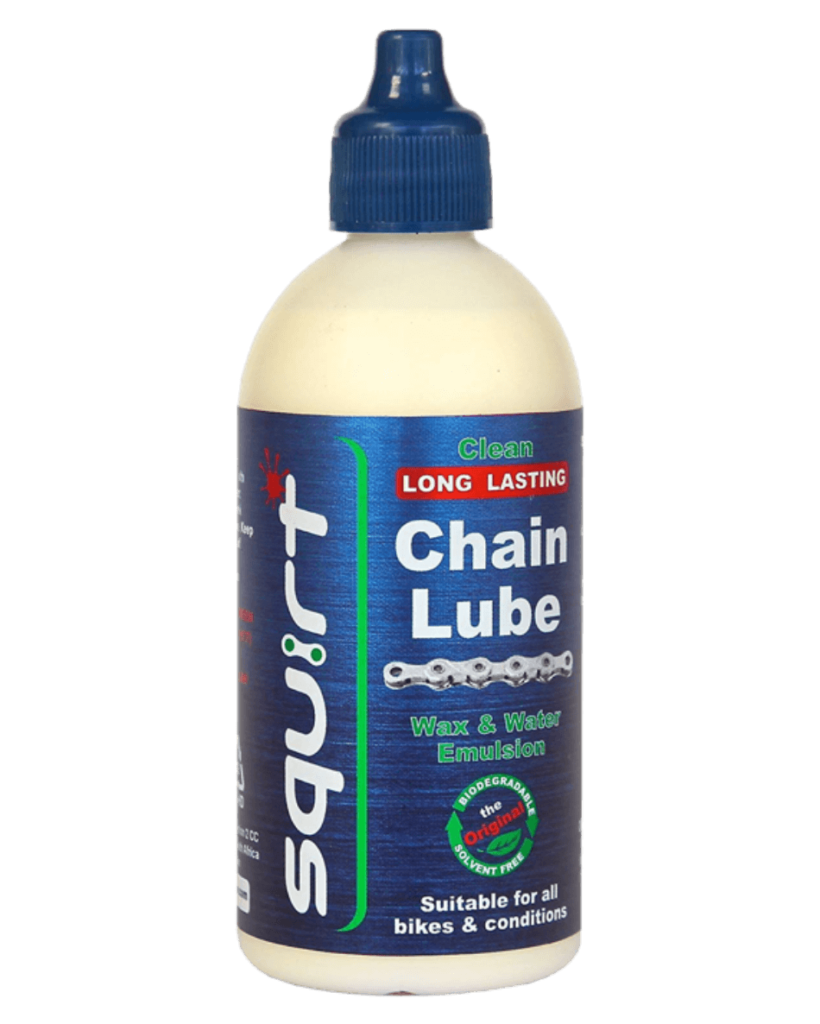
Our Rating
9.8/10
$12.99
at amazon.com
KEY SPECS
| Type | Wax-based |
| Bottle size | 120ml |
PROS
- lasts longer than oil-based lubes
- doesn’t attract dirt
- increased drivetrain efficiency
CONS
- washes off easily in the wet
- requires chain prep before application
Squirt is a wax-based chain lube and a longer-lasting alternative to traditional oil lubricants. Squirt was originally a system mounted on the bike designed to lubricate the chain while moving. The three founders, an engineer, a pharmacist, and a mountain biker, ended up making a biodegradable wax-based lube that was so long-lasting that there’s no need to apply it on the go.
The lubricant was developed during extensive testing in South Africa, where the dry conditions and dirt pose a challenge. Oil lubes often collect grime and turn black, but Squirt’s wax coating prevents the build-up of contaminants and lasts longer. With a wax-based lube, riders have to go through the extra step of cleaning the chain before application.
Squirt has a long lifespan on the chain in normal conditions but washes off relatively easily in wet conditions, knocking half a point off its overall rating. This is par for the course for most lubes, but I noticed this happens a bit faster than competing lubes. Choose this lube if you want professional performance and don’t mind a bit more maintenance to get the most out of your drivetrain.
Best Race Day Lube
2. Muc-Off C3 Ceramic Lube
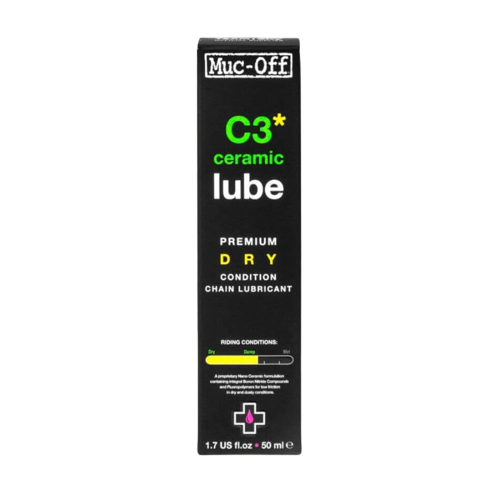
Our Rating
9.5/10
$15.99
at amazon.com
KEY SPECS
| Type | Oil / ceramic |
| Bottle size | 120ml |
PROS
- quiet drivetrain
- UV light
CONS
- doesn’t hold up in severe wet conditions
Muc-Off C3 ceramic dry chain lube is a high-performance formula for moderate riding conditions. The biodegradable lubricant uses advanced ceramic polymers that coat the chain in an ultra-low friction layer. The lube is ideal for dry conditions where riders prioritize speed over protecting their chain from harsh weather or mud.
Muc-Off has a reputation for being an innovative and creative brand and this lube doesn’t disappoint. The ceramic lube also carries a UV dye that glows under a blacklight so riders can check if the coating is distributed over the entire chain now that’s cool.
As a multipurpose chain lube, the C3 formula performs decently well in wet conditions so you can rest easy if you come across unexpected showers or puddles. It won’t hold up in the wet forever, though, lowering its overall rating slightly.
Best Lube When Money is No Object
3. CeramicSpeed UFO Drip
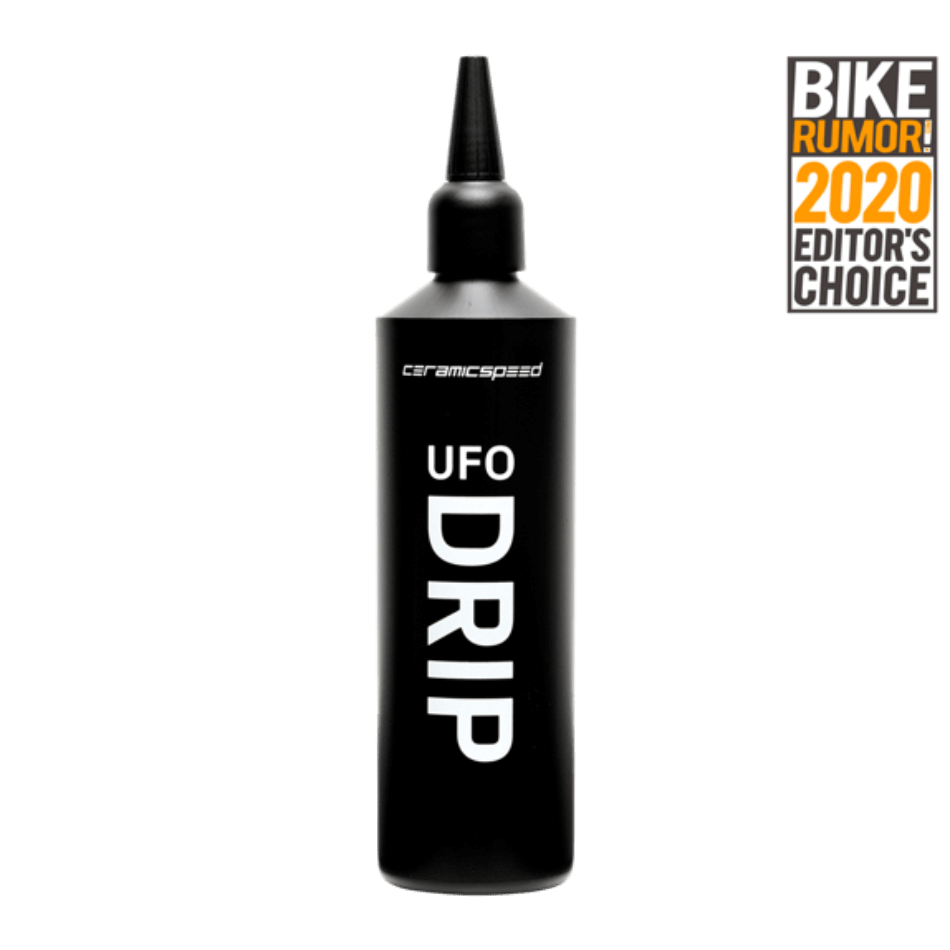
Our Rating
8.5/10
$44.95
at amazon.com
KEY SPECS
| Type | Wax-based / ceramic |
| Bottle size | 6 oz / 177ml |
PROS
- drivetrain efficiency and speed
- lasts up to 300km per coating
- bio-degradable
CONS
- only available in a large bottle
- expensive
CeramicSpeed UFO Drip ceramic lube is a race-specific solution to achieve maximum drivetrain efficiency and keep contaminants at bay. CeramicSpeed, a brand known for its low-friction components and ball bearings, has updated the lubricant formula. This new formula performs well in independent industry studies from Zero Friction Cycling and Road Energy.
The lube is composed of waxes, oils, and particulates that CeramicSpeed calls ‘friction modifiers’, which create a super slippery coating. The low friction layer covers the entire chain, so it’s important to start with a new or thoroughly cleaned chain. Many riders will be pleased to know that the lube is biodegradable.
This lube doesn’t score full marks because of its hefty price tag. This version is one of the fastest bike lubes available, so it’s well-loved by racers and professional riders. It costs a pretty penny and is only available in a large 6oz bottle, but the extra race pace is worthwhile.
Best All-Conditions Lube
4. Smoove Lube
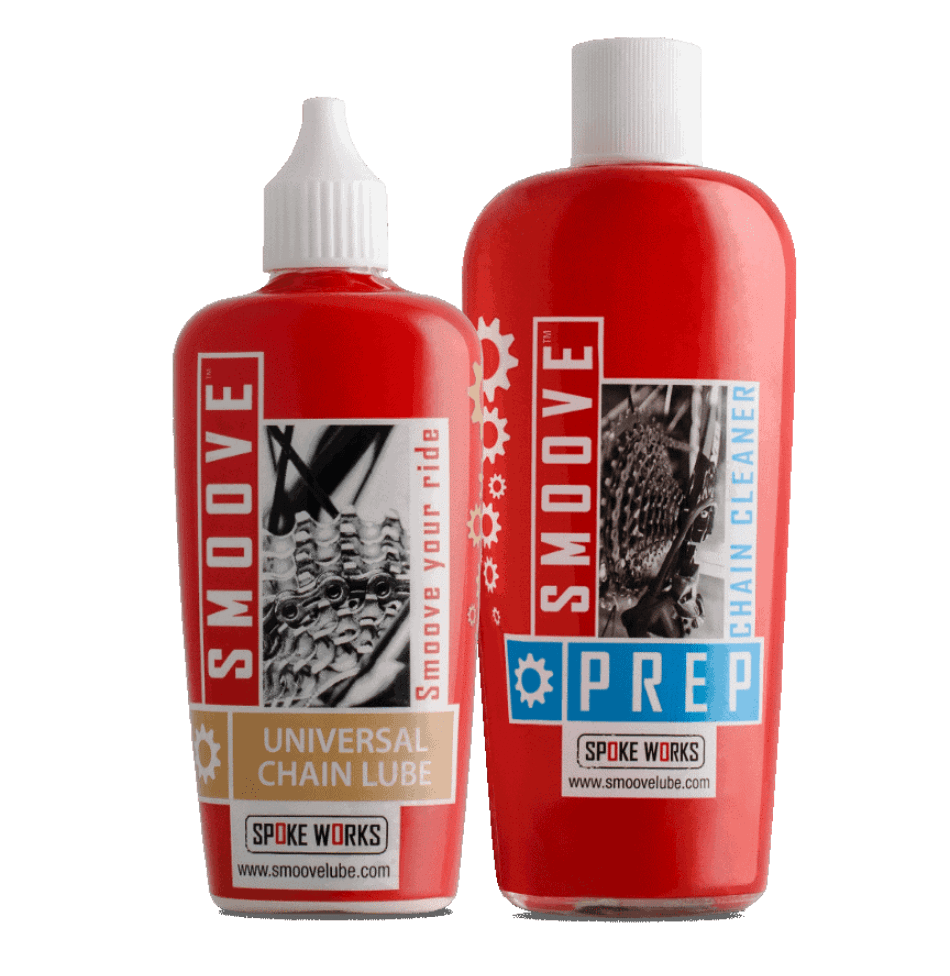
Our Rating
8.5/10
$14.95
at amazon.com
Save 29%
KEY SPECS
| Type | Wax-based |
| Bottle size | 125ml |
PROS
- easy-application nozzle
- long-lasting in extreme conditions
- keeps dirt away
CONS
- requires a clean chain for proper application
Another product on this list that was designed to handle the tough conditions of South Africa, Smoove is an impressive wax-based lube that lasts longer than most.
The brand’s founder Ruan Deyzel recognized that oil-based lubes attracted far too much dirt and opted for a wax-based recipe to keep the chain clean. He discovered it was much longer-lasting than expected, and pro MTB teams soon caught on to the quality product.
Since it’s wax-based, Smoove lube requires that the chain be thoroughly cleaned before application, so no grime is trapped under the wax coating. That extra step might be a nuisance for some riders, but I think the long-lasting performance is well worth the prep time. The wax coating also reduces chain noise so it runs virtually silent.
This is a great option but misses out on a full 10 rating because of the extra steps to apply it to a squeaky clean chain. Smoove lube isn’t the cheapest option on this list, but its longevity and dirt-repelling qualities mean you’ll get your money’s worth out of every application.
Best Lube for Wet Conditions
5. Finish Line Wet Lube
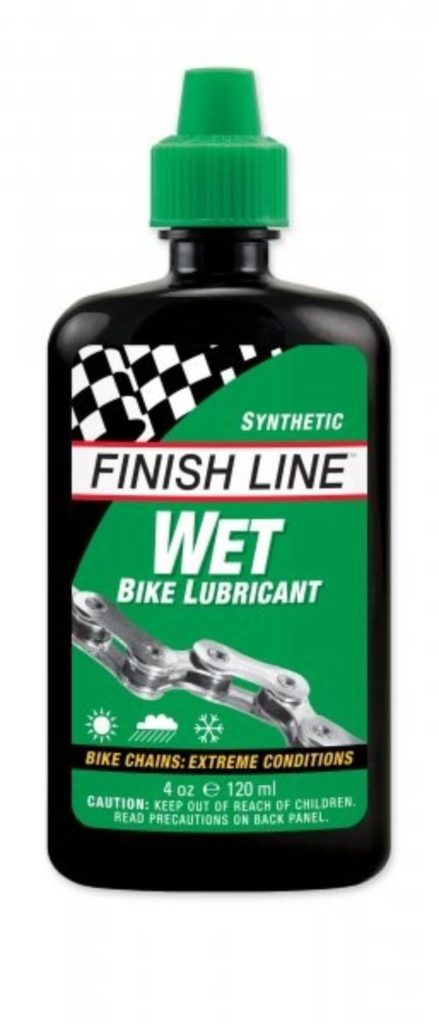
Our Rating
8/10
$12.90
at amazon.com
KEY SPECS
| Type | Wet |
| Bottle size | 120ml |
PROS
- stays on even in the wet
- great value
CONS
- attracts dirt
- thick viscosity can get messy
The Finish Line brand is one of the most popular brands out there and its wet lube has reliably served cyclists for decades. Finish Line Wet lube is designed to stay on the chain even in the heaviest rain to prevent rust and keep the drivetrain operating smoothly. The unique formula combines synthetic oils, hydrophobic polymers, and other additives to boost performance.
This lube is best reserved for inclement weather when other lubes would simply wash away and leave the chain exposed to wear. The thick viscosity is similar to grease, so it’s a bit of a magnet for dirt and grime during normal rides, knocking a point off its rating. Check out Finish Line’s Teflon Plus lube if you typically ride in dry conditions.
Finish Line Wet lube is a great option for winter riding when the weather can take a turn for the worst. If you have a long journey coming up and expect wet conditions, this lube will stay on the chain the entire time so you can rest easy. Just be prepared for a bit of a mess if you ride on dirt or have to remove the lube for deep cleaning.
Best Eco-Friendly Lube
6. Green Oil Wet Lube
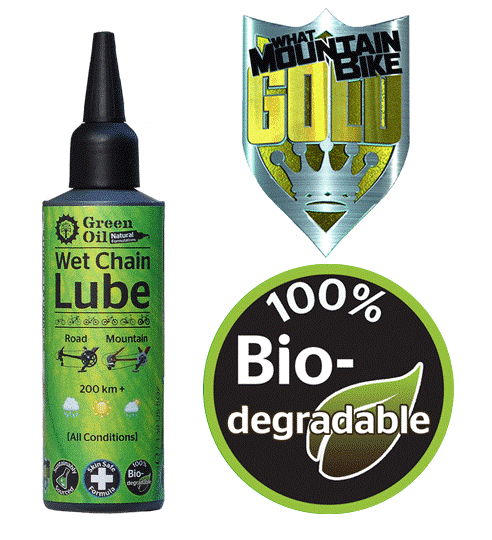
Our Rating
7.8/10
$16.99
at amazon.com
KEY SPECS
| Type | Oil-based / Wet |
| Bottle size | 100ml |
PROS
- repels dirt fairly well
- lasts long in wet conditions
- noise-free chain
- environmentally friendly
CONS
- expensive
Biking is an environmentally friendly form of recreation, so it makes sense that chain lube should be good for the planet as well. This lube from Green Oil is a biodegradable lubricant made from plant-based materials designed to last long in wet weather. The bottle is made from 100% recycled plastic, too!
Green Oil Wet lube has a medium viscosity that is a bit thinner than the Finish Line wet lube, so it doesn’t attract as much dirt and contaminants. That said, it’s still thick enough to stay on the chain no matter the weather. This lube can handle serious rain, puddles, and getting sprayed by a hose while you clean your bike after a ride. The slightly high price tag for volume takes a point away from this lube’s overall rating.
The green formula avoids harsh chemicals such as PTFE and PFCA that help with lubrication but are destructive to the environment. Green Oil uses the plant extract N-Toc instead, which provides just as much lubrication while taking care of the planet. If you are searching for ways to be more sustainable, Green Oil wet lube is a great choice that doesn’t sacrifice performance.
Frequently Asked Questions
Bike-specific lubricants specific to the conditions you will be riding in are the best choice. Think about the weather where you ride and select a lube on this list that is designed for dry, wet, general, or racing conditions.
Wax-based chain lubes stay the cleanest the longest because they don’t attract as much dirt and grime as oil-based lubricants. The application isn’t as sticky and the wax coating flakes off over time, taking any accumulated contaminants with it.
While WD-40 won’t damage your chain, it’s only an effective light lubricant in dry, clean conditions. It is primarily a cleaner and doesn’t last long in wet conditions.

Jeffrey Brown is a writer, editor, and professional bike mechanic with over 7 years of experience working in full-service and community-based bike shops. As a bicycle educator, he has supported youth programs across the US that teach bike mechanics and life skills to prepare the next generation of cyclists.
Jeffrey began his professional mechanic career at his university bike co-op, so he recognizes the grassroots power of the cycling community. Initially self-trained as a mechanic, his subsequent positions as manager and lead educator gave him official training. He has won various awards and grants for his role as a bicycle and environmental advocate.




